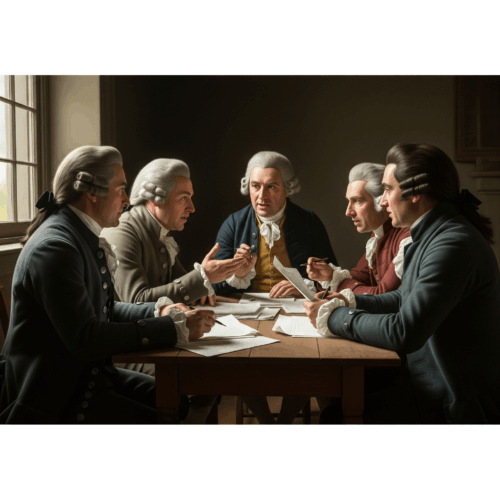 Revolutions rarely begin with a bang. More often, the thunderous moments we remember—the battles, the speeches, the public declarations—are the final results of quiet, deliberate, and often tedious work done by small groups of people in stuffy rooms. The real work of change isn’t always in the streets; it’s in the architecture of the idea itself.
Revolutions rarely begin with a bang. More often, the thunderous moments we remember—the battles, the speeches, the public declarations—are the final results of quiet, deliberate, and often tedious work done by small groups of people in stuffy rooms. The real work of change isn’t always in the streets; it’s in the architecture of the idea itself.
On this day, June 11, 1776, one such moment occurred. It wasn’t a day of cannon fire or bloodshed. It was a day of procedure. In Philadelphia, the Second Continental Congress, a body of men wrestling with the immense gravity of treason and the birth of a nation, made a decision. After Richard Henry Lee of Virginia had formally proposed that the colonies should be “free and independent States,” the Congress knew it needed more than just a vote. It needed a voice. It needed a mission statement. It needed to explain itself to the world, to the king, and most importantly, to its own people.
So, on June 11th, they formed a committee. A committee of five men was appointed to draft a declaration that would articulate the “why” behind their monumental decision. This was not a flashy assignment; it was an intellectual and political challenge of the highest order. The men chosen were John Adams of Massachusetts, Benjamin Franklin of Pennsylvania, Thomas Jefferson of Virginia, Roger Sherman of Connecticut, and Robert R. Livingston of New York.
This small, procedural act—the formation of the “Committee of Five”—was the architectural phase of the American Revolution. It was the moment the foundation was laid for the document that would become the Declaration of Independence. What they did in the following weeks provides a powerful, timeless blueprint not for overthrowing a government, but for initiating any profound and lasting change in our own lives. Their process can become your process.
The Team and The Task: More Than Just Words
 The genius of the Continental Congress was in who they chose. This wasn’t just a collection of the five best writers. It was a strategically assembled team, a blend of temperaments and talents, designed to produce a document that was both radical in its ideals and pragmatic in its purpose.
The genius of the Continental Congress was in who they chose. This wasn’t just a collection of the five best writers. It was a strategically assembled team, a blend of temperaments and talents, designed to produce a document that was both radical in its ideals and pragmatic in its purpose.
- Thomas Jefferson: The primary author. Just 33 years old, he was known for his powerful, eloquent prose and his deep immersion in Enlightenment philosophy. He was tasked with being the architect, the one to put the vision to paper.
- John Adams: The engine. A fiery, passionate advocate for independence, he was the political driver. He ensured the project had momentum and fought for its passage in the contentious halls of Congress.
- Benjamin Franklin: The sage. World-renowned as a scientist, diplomat, and writer, he was the elder statesman. His wisdom, wit, and editorial eye would provide grounding, perspective, and crucial revisions.
- Roger Sherman: The pragmatist. A self-made man from a humble background, he was known for his common sense and steady hand. He represented the practical, no-nonsense spirit of the colonies.
- Robert R. Livingston: The cautious voice. Representing the more conservative New York delegation, he was not yet fully convinced of the necessity of a complete break. His presence ensured that the document would have to be persuasive enough to win over the skeptics.
This was a masterclass in team building. It wasn’t about finding five people who agreed; it was about finding five people who, together, could create something stronger than any one of them could alone. They had a visionary, an engine, a sage, a pragmatist, and a skeptic. Together, they were tasked with drafting not just a legal document, but the very soul of a new nation. They spent the next two weeks debating, drafting, and editing, turning a radical idea into immortal prose.
The lesson is profound: True, lasting change requires more than a single visionary. It requires a balanced team, a process of refinement, and the courage to put a powerful idea into clear, unwavering words.
Your Declaration of Personal Independence: A 5-Step Plan
The process that began on June 11, 1776, is a direct model for achieving any major life goal. Whether you want to start a business, change careers, achieve a new level of health, or break free from a limiting mindset, you can adopt the framework of the Committee of Five.
 Here is your plan to build the architecture for your own revolution.
Here is your plan to build the architecture for your own revolution.
Step 1: Define Your “Lee Resolution” (State Your Core Principle)
Before the committee was formed, Richard Henry Lee stood before Congress and made a clear, bold proposal. He didn’t say, “We should think about being less British.” He said the colonies “are, and of right ought to be, free and independent States.”
- Your Action: Before you do anything else, you must define your core purpose in a single, powerful sentence. Vague desires like “I want to be happier” or “I want to be healthier” are not enough. Get specific. What is the fundamental state of being you are resolving to achieve?
- Examples:
- “I resolve to be the sole owner of a profitable business that aligns with my personal values.”
- “I resolve to achieve a state of physical and mental health where I feel energetic and free from anxiety.”
- “I resolve to build a life where my finances are a tool for freedom, not a source of stress.”
Write this down. This is your “Lee Resolution.” It is the guiding star for everything that follows.
Step 2: Assemble Your Personal “Committee of Five” (Build Your Support System)
Jefferson didn’t write the Declaration in a vacuum. He was surrounded by a team that provided energy, wisdom, pragmatism, and skepticism. You need the same. This isn’t about finding five people to do the work for you, but about identifying the roles and resources you need.
- Your Action: Identify the people (or mindsets) who will form your personal committee.
- Your John Adams (The Engine): Who is your biggest cheerleader? Who will push you when you want to quit? This could be a best friend, a spouse, or a motivational mentor.
- Your Benjamin Franklin (The Sage): Who has the wisdom and experience you lack? A mentor, an expert in the field you’re entering, or even a collection of trusted books and podcasts can fill this role.
- Your Roger Sherman (The Pragmatist): Who will keep you grounded? This is the person who asks, “That’s a great idea, but how will you pay for it?” They aren’t trying to crush your dream; they are ensuring it’s built on a solid foundation.
- Your Robert Livingston (The Skeptic): This is the voice of your own inner doubt, or a trusted person who plays devil’s advocate. You don’t let this voice win, but you must listen to it. It forces you to strengthen your arguments and anticipate obstacles.
- Your Thomas Jefferson (The Author): This is you. You are the one who must ultimately do the work, hold the vision, and write your own story.
Step 3: Write Your First Draft (Articulate Your Vision)
Jefferson retired for several days and produced the first draft. It wasn’t perfect, but it was the tangible expression of the committee’s goal. It gave them something to work with.
- Your Action: Take your “Lee Resolution” and expand it. Write out what your new reality looks like in detail. What are the “self-evident truths” of the life you are building? What does a typical day look like? What are you doing? How do you feel? Don’t worry about perfection; just get the vision out of your head and onto paper. This is your mission statement, your business plan, your personal constitution.
 Step 4: Submit for Edits (Embrace Collaboration and Refinement)
Step 4: Submit for Edits (Embrace Collaboration and Refinement)
Jefferson’s draft was reviewed and edited first by Adams and Franklin, and then by the entire committee, before finally being submitted to Congress, who made even more changes. The final document was a collaborative masterpiece, stronger for the revisions it endured.
- Your Action: Take your first draft to your “committee.” Let your “engine” get you excited about it again. Let your “sage” offer wisdom and perspective. Let your “pragmatist” poke holes in the plan. Listen to the arguments of your “skeptic” and strengthen your defenses. Be willing to kill your darlings. This process of refinement is not a sign of weakness; it is the path to excellence.
Step 5: Proclaim and Publish (Commit to Your Declaration)
On July 4, 1776, the Declaration was formally adopted and read aloud. The signatures came later, but the public proclamation was the point of no return. It was a commitment.
- Your Action: This isn’t about posting your plan on social media (unless that helps you). It’s about making a formal commitment. Sign your own declaration. Read it aloud to your “committee.” Take the first, irreversible step that your plan calls for—make the phone call, register the domain name, sign up for the class, throw out the junk food. This is the moment your architectural plan becomes a construction site. You have published your intent, and now you must act on it.
 The Beginning of Everything
The Beginning of Everything
June 11, 1776, teaches us that the most powerful changes are not accidents. They are designed. They are architected with intention, built with collaboration, and proclaimed with courage. The fire of revolution needs a blueprint to channel its energy, otherwise it simply burns itself out.
Your life is your nation. You have the right to declare your independence from the tyrannies of fear, doubt, and circumstance. You have the right to institute a new government for yourself, founded on principles of your own choosing.
It all begins not with a bang, but with a quiet, deliberate decision. It begins when you decide to form a committee, draft a plan, and build the architecture for a new world.

